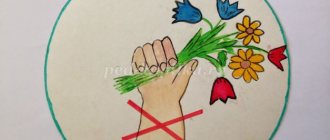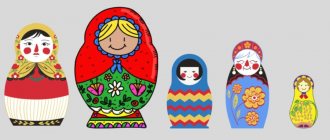Card index of communicative games (first junior group)
Alexandra Komar
Card index of communicative games (first junior group)
Communication games
for young children
Guidelines
Communication is one of the conditions for the mental development of a child. It affects the results of all the most important types of activities: study, work, play, social orientation, etc. But mainly communication has an impact on the development of the personality of children with special educational needs, promotes their socialization and integration into a peer group . At the same time, it is not an innate activity. Therefore, only through specially organized training and education can significant success be achieved in the development of communication.
At the age of 2-3 years, communication with peers becomes increasingly important. This is due to the fact that meaningful communication between peers arises on equal terms, therefore:
- children strive to interest themselves and attract the attention of peers;
- respond sensitively to any action of a peer;
It is from the moment when interest in another child begins to show that children need to be taught to communicate with each other.
For the purpose of communication between children, an adult:
- helps the child see a person in a peer;
— organizes joint games for children;
— teaches friendly communication;
- encourages attracting attention to peers, calling by name, affectionate words, etc.
Let's consider several options for games aimed at developing communication skills in young children. The proposed games can be used in working with children with special educational needs.
Game "Tender name"
Goal: learn to interact with each other, say the name of another child.
Children stand in a circle, each of them takes turns entering the center. All other children, with the help of an adult, name variations of the affectionate name of the child standing in the center of the circle.
Game “Who came to visit us?”
Goal: to promote the development of self-esteem in children; activate children's friendly attitude towards their peers.
the group aside and agrees with them that they will portray animals that will come to visit the children. Children decide which animals they will portray. Children stand in a circle. The guests take turns entering the circle. The adult says to the children: “Look what a wonderful animal has come to us, what eyes it has, how beautifully it moves, etc.” Children need to guess what animals came to them and what mood they were in.
A game «»
The bird's wing hurts"
Goal: to promote in children the ability to love others.
One of the children turns into a bird whose wing hurts. He tries to show that he is sad. The presenter invites the children to “feel sorry for the bird”
.
The first to “pity”
her is the presenter himself, who puts a kitten doll on his hand and strokes
the “bird”
with the words: “Bird...
(Sasha, Masha)
is good.”
Then other children put on the kitten doll and also “feel sorry for the bird
.
Game "Let's play together"
Goal: teach children to interact and treat each other politely.
Equipment: paired toys (ball-groove, train-car, cube machine)
.
An adult distributes toys to children, places children in pairs, and invites them to play together. Then he helps each of the children perform object-based play actions in accordance with the purpose of each toy. At the end of the game, the adult records who played with whom, calling each child by name: “Anya played with Dasha - they rolled a ball, Dima played with Vasya - they drove a train, Petya played with Lena - they loaded and carried cubes in the car.”
Game "Our Sun"
Goal: to promote the unification and interaction of children in the group .
An adult draws a circle on whatman paper. Then he outlines the palms of the children, thus creating rays of the sun. With the help of an adult, children color the drawn palms. The result is a beautiful multi-colored sun, which is hung in a group .
The game “who can wake you up better”
Goal: to promote in children the ability to love others.
One child turns into a cat and falls asleep - lie down on the rug in the center of the group . The presenter asks to take turns waking up the “sleeping cat”
.
It is advisable to do this in different ways (with different words and touches, but each time affectionately. At the end of the exercise, the children all decide together who “woke up the kitty”
most affectionately.
Game “I’ll show you how much I love”
Goal: to promote in children the ability to love others.
An adult says that you can show a person that you love him only with touches, without words. Then one of the guys turns into his mother, the other into her
Son, and show how much they love each other. The next couple is “mother”
and
“daughter”
, then
“grandmother”
and
“grandson”
, etc.
Game "A leaf is falling"
Goal: develop the ability to collaborate.
An adult raises a sheet of paper above the table (at a distance of about a meter, then lowers it and draws the children’s attention to how smoothly it falls down and lies on the table. After this, the presenter asks the children to turn their hands into pieces of paper. The presenter again raises the sheet of paper - children raise their hands up. The adult lowers the sheet, it goes down to the table. Children need to do the same, that is, smoothly lower their hands onto the table at the same time as the sheet of paper. The exercise can be repeated several times. The presenter emphasizes the children’s ability to act in concert, together.
Game “I can’t be offended, oh, I laugh, I crow!”
Goal: to help reduce resentment in children.
One child sits on the “magic chair”
, the other should pretend to offend him. The adult begins to say the words:
“I can’t be offended...”
- the child continues:
“Oh, I’m laughing, I’m crowing!”
Game "Animal Piano"
Goal: to develop children's ability to cooperate.
Children squat in one line. They are piano keys that sound like the voices of different animals. The presenter gives the children cards with images of animals whose voices will sound “keys”
(cat, dog, pig, mouse, etc.)
Then the adult touches the children’s heads, as if pressing keys. The keys need to sound like the voices of the corresponding animals.
Game "Locomotive"
Goal: to teach the child to respond to his name, remember the names of peers, and act according to demonstration and verbal instructions.
The adult explains to the children that now they will play train. The main locomotive will be the adult, and the children will be the carriages. He calls the children one by one, emotionally commenting on what is happening : “I will be the locomotive, and you will be the carriages. “Petya, come to me, stand behind me, hold my belt, like this. Now Vanya, come here, stand behind Petya, hold him by the belt,” After all the children lined up, “train”
hits the road.
An adult, imitating the movement of a steam locomotive “Chuk-chukh, oo-oo-oo!”
encourages children to repeat them.
Game "Pass the Ball"
Goal: learn to interact with peers.
Children stand opposite each other. An adult, showing children how to correctly hold and pass the ball to another child, calling him by name ( “Here, Petya!”
).
The game is emotionally supported by an adult.
Game "Affectionate Child"
Goal: continue to teach children to imitate emotional, tactile and verbal ways of interacting with a partner.
Children sit on chairs in a semicircle in front of an adult. He calls one of the children to him and shows how to hug him, lean against him, look into his eyes, and smile. “Oh, how good Sasha is, come to me, I’ll hug you, like that.
Look, kids, how I hug Sasha, like this. I'm affectionate! Then the adult invites another child to his place and invites him to repeat all his actions, emotionally emphasizing each child’s action and, if necessary, providing him with help. At the end of the game, the adult emphasizes and sums up all the child’s actions: “Vanya hugged Sasha, looked into his eyes, and smiled. That’s what Vanya is, an affectionate child!” Then the adult calls the remaining children one by one and the game is repeated.
How to help your child fit harmoniously into the kindergarten team
Imagine that you suddenly find yourself in a tribe completely unknown to you, where people, although they speak a language you understand, live by completely different laws and observe traditions that seem, to put it mildly, terrible to you.
What will you experience when you realize that you are now forced to spend most of your time in this tribe and live according to its laws? Shock? Confusion? Horror? Panic? A child experiences the same thing when he enters kindergarten. After all, a children's team is an independent state, which has its own unwritten laws and rules. And in order to exist in this state, a child needs to understand and comply with these laws. Some commercial kindergartens have full-time psychologists who help children fit harmoniously into the team, monitor the kids and tell parents what behavioral and educational tactics they should follow at one time or another. Unfortunately, such kindergartens are still rare, and many young parents cannot afford them. But in ordinary kindergartens, let alone a psychologist, there are not enough teachers, and the main task of the staff is to make sure that all the children are fed, clothed, shod, and do not injure each other. Ordinary teachers and nannies physically have no time to go into the psychological subtleties of the child’s relationship with the team. And as a result, when sending their child to a regular kindergarten, parents and the child are faced with a number of psychological difficulties.
Middle group: from 4 to 5 years
Age-related communication difficulties
. At 4-5 years old, a child does not separate himself from the group. He increasingly uses the pronoun “we” instead of “I.” The child realizes that by acting together, one can achieve much more than alone, and at the same time avoid punishment. After all, the teacher is unlikely to find out who exactly poured paint on the floor and who broke the window. The principle of this age is “Where everyone goes, I go too.” Moreover, the child does not care at all whether he follows a good or bad example to follow. From the entire team, the child singles out several children whom he tries to imitate in everything.
In the children's team, there are clear leaders - the ringleaders and organizers of all the pranks. At this age, the leader in the team has much greater authority than the parent or teacher. The main thing for a child is that the team accepts him and does not ignore him. For a 4-5 year old child, there is nothing worse than a boycott of the team. At this age, the children's team does not forgive those who stand out from the crowd in some way. Therefore, children try to imitate recognized leaders in everything. At this age, children often unite in groups according to the principle “we are friends against Vasya (Petya Masha).”
How to overcome them
. You can repeat the tirade as much as you want about how you need to think with your own head. But if a child does not know how to adequately evaluate the actions of others and is afraid to express his own point of view, he will continue to live by the principle “where everyone else goes, I go there too.” Teach your child to analyze his own and other people's actions. Only by learning to evaluate the behavior of other people will a child be able to determine whether they are doing good or bad, and whether it is worth following this example. The child must understand that he should have his own opinion on any matter, and not listen to Vasya or Dasha. If you openly object to his imitation of any of his peers, the child is unlikely to listen; rather, on the contrary, he will only move away from you, because you do not share his admiration for the brawler Petya or the liar Nastya. The task of parents and educators is to form adequate self-esteem in the child. Emphasize the child's individuality. Only a brave and self-confident person will not be afraid to openly express an opinion different from the opinion of the majority.
And do not extort information from the child about who exactly is the organizer and organizer of all the pranks - the children's team does not forgive traitors. And if you force a child to “pawn” his peers, there is a high probability that next time he will be the outcast.
The most typical age-related communication problems and ways to solve them
Every age has its own communication difficulties. Some children are more likely to have certain problems, while others are more likely to have others. It all depends on the character and temperament of the child. And if you passed the first year in the nursery group without any particular difficulties, this does not mean at all that now the child will be happy to go to kindergarten and will not have any problems. The difficulties listed below do not go away as you grow older. If at 5-6 years old a child comes to kindergarten for the first time, he is faced with a number of difficulties that his peers experienced in previous groups. To overcome age-related communication difficulties, you must survive them. Conventionally, the age-related problems of a preschooler can be divided into four groups, which correspond to the age groups of a kindergarten.





